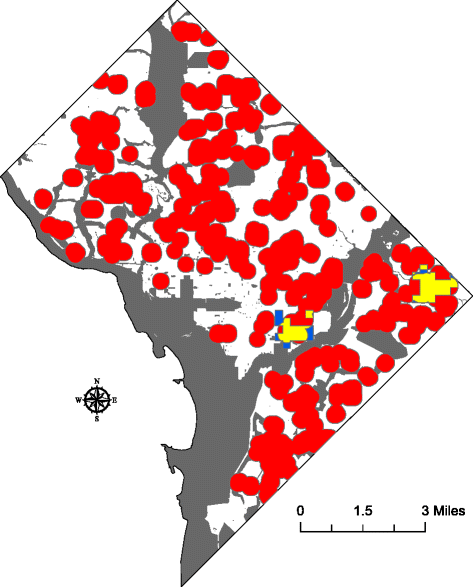BACKGROUND:
Copious evidence indicates that syringe exchange programs (SEPs)
are effective structural interventions for HIV prevention among persons who
inject drugs (PWID). The efficacy of SEPs in supporting the public health needs
of PWID populations is partially dependent on their accessibility and
consistent utilization among injectors. Research has shown that SEP access is
an important predictor of PWID retention at SEPs, yet policies exist that may
limit the geographic areas where SEP operations may legally occur. Since 2000
in the District of Columbia (DC), SEP operations have been subject to the 1000
Foot Rule (§48-1121), a policy that prohibits the distribution of "any
needle or syringe for the hypodermicinjection of any illegal drug in
any area of the District of Columbia which is within 1000 feet of a public
or private elementary or secondary school (including a public charter
school)." The 1000 Foot Rule may impede SEP services in areas that are in
urgent need for harm reduction services, such as locations where injections are
happening in "real time" or where drugs are purchased or exchanged.
We examined the effects of the 1000 Foot Rule on SEP operational space in injection drug use
(IDU)-related crime (i.e., heroin possession or distribution) hot spots from
2000 to 2010.
METHODS:
Data from the DC Metropolitan Police Department were used to
identify IDU-related crime hot spots. School operation data were
matched to a dataset that described the approximate physical property
boundaries of land parcels. A 1000-ft buffer was applied to all school property
boundaries. The overlap between the IDU-related crime hot spots and
the school buffer zones was calculated by academic year.
RESULTS:
When overlaying the land space associated with
IDU-related crime hot spots on the maps of school
boundaries per the 1000-ft buffer zone stipulation, we found that the majority
of land space in these locations was ineligible for legal SEP
operations. More specifically, the ineligiblespace in the identified hot spots in
each academic year ranged from 51.93 to 88.29 % of the total hot spot
area.
CONCLUSIONS:
The removal of the 1000 Foot Rule could significantly
improve the public health of PWID via increased access to harm reduction
services. Buffer zone policies that restrict SEP operational space negatively
affect the provision of harm reduction services to PWID.
Below: IDU-related crime hot spots and school buffer zones in the 2008 academic year
Full article at:
- 1Department of Epidemiology, Johns Hopkins University, 615 N. Wolfe St., Baltimore, MD, 21205, USA. sallen63@jhu.edu.
- 2Department of Prevention & Community Health, Milken Institute School of Public Health at The George Washington University, 950 New Hampshire Ave, Suite 300, Washington, DC, 20052, USA.
- 3Department of Health Policy & Management, Jiann-Ping Hsu College of Public Health at Georgia Southern University, PO Box 8015, Statesboro, GA, 30460, USA
- Harm Reduct J. 2016 Apr 26;13(1):16. doi: 10.1186/s12954-016-0104-3.
More at: https://twitter.com/hiv
insight


No comments:
Post a Comment